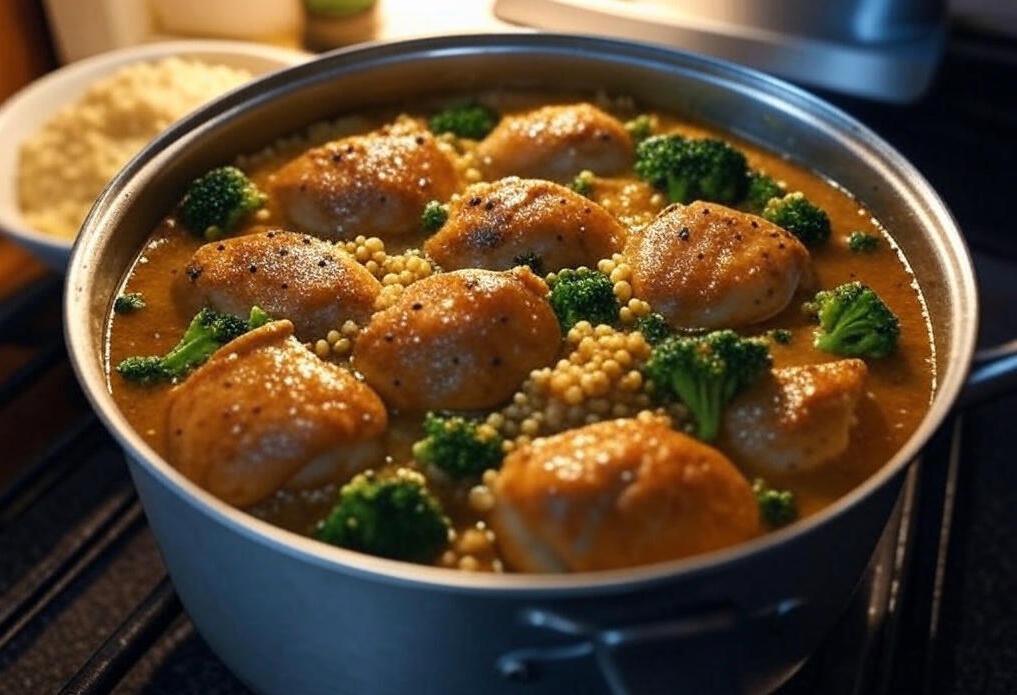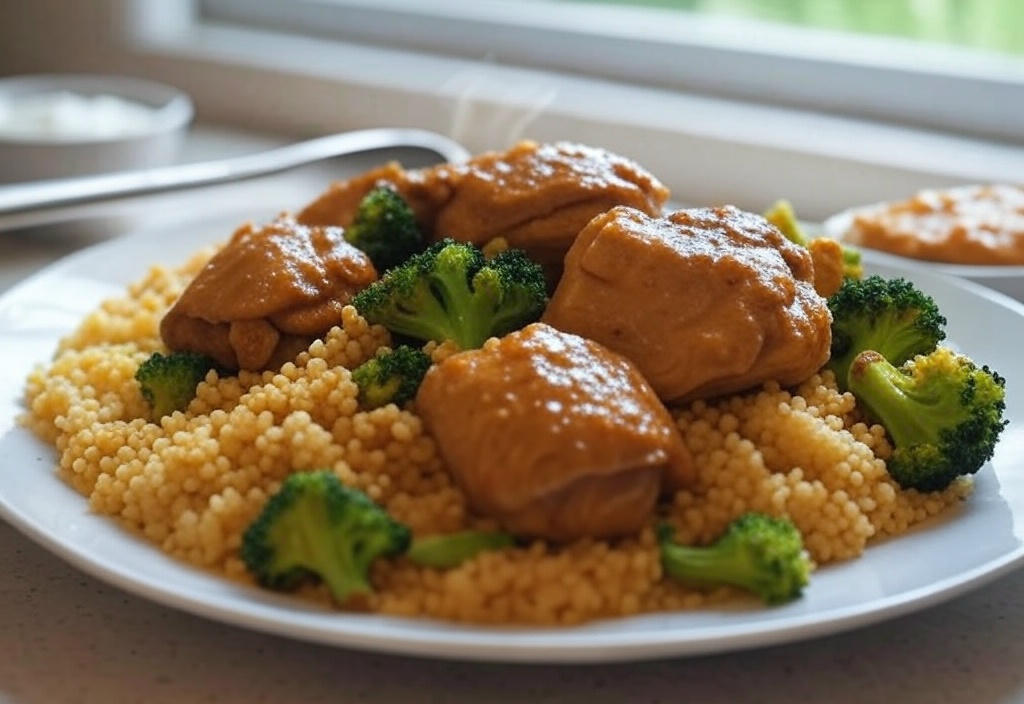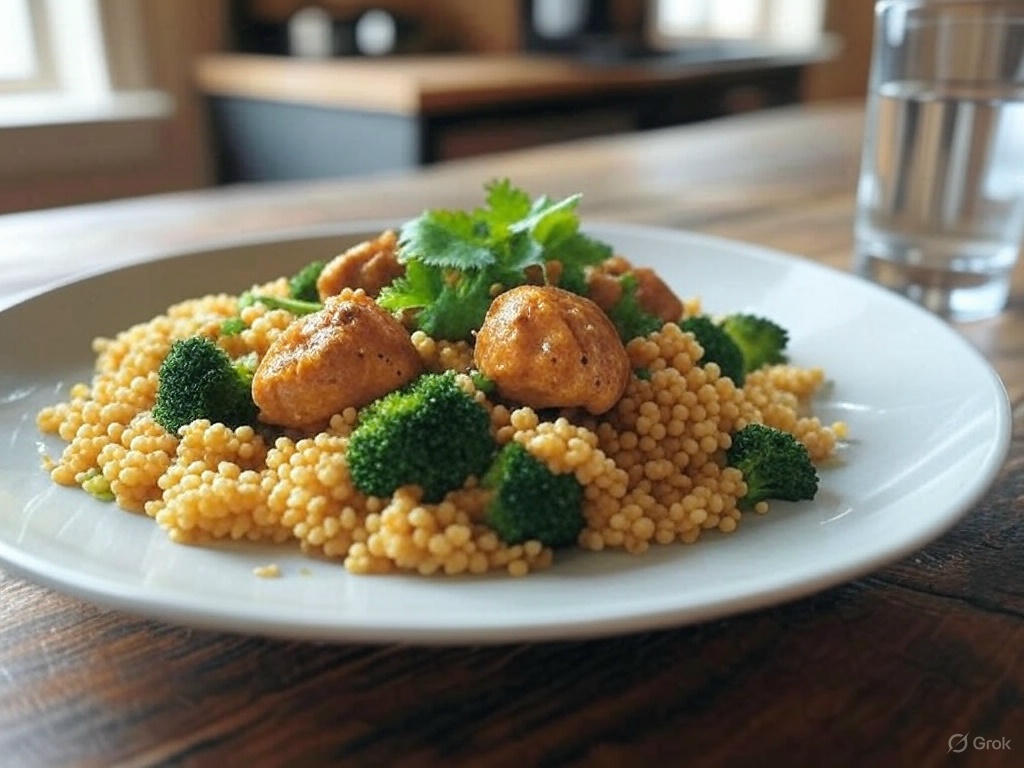Introduction to the Recipe and its Key Ingredients
This vibrant and flavorful Curry-Spiced Chicken with Couscous and Broccoli dish is a delightful fusion of aromatic spices and comforting grains. It’s a remarkably versatile recipe, perfect for a weeknight dinner or a meal prep session, offering a substantial and satisfying experience without requiring extensive cooking time. At its core, this recipe leverages the classic combination of tender chicken, fluffy couscous, and a generous helping of tender-crisp broccoli, all enveloped in a complex and warming curry sauce. The spice blend is the key to unlocking the dish’s true potential – it’s a carefully crafted mixture of turmeric, cumin, coriander, garam masala, and a touch of chili powder, creating a depth of flavor that is both stimulating and deeply comforting. Curry Spices are a great starting point, though feel free to adjust the ratios to suit your personal preference for spice levels. Couscous, a staple of North African cuisine, adds a delightful texture – light, airy, and perfectly capable of absorbing the rich curry sauce. Couscous Types provide a nice base for the flavors. Broccoli, a nutritional powerhouse, provides a welcome burst of freshness and essential vitamins. Broccoli Benefits are many, and incorporating it ensures a well-rounded and wholesome meal. The recipe is designed to be adaptable; you can easily swap in other vegetables like cauliflower, peas, or bell peppers to tailor it to your tastes and seasonal availability. Vegetable Variations offer exciting ways to experiment. The foundation of this recipe is built on simple ingredients, making it accessible to home cooks of all skill levels. It’s a fantastic option for those seeking a flavorful and nutritious meal without the fuss. The beautiful colors of the dish, from the golden curry to the vibrant green broccoli, add an aesthetic appeal that elevates the dining experience. Food Styling Tips can add to the presentation. This dish is a testament to how a few carefully chosen ingredients, combined with a touch of culinary creativity, can result in a truly memorable meal.
Step-by-Step Cooking Instructions for Perfect Flavor
Let’s embark on a flavorful journey to create this exceptional Curry-Spiced Chicken with Couscous and Broccoli. The key to a truly outstanding dish lies in carefully executing each step, allowing the spices to bloom and meld together perfectly. Don’t rush—this is where the magic happens!
Step 1: Preparing the Aromatics (5 minutes)
Begin by finely chopping one medium yellow onion onion and two cloves of garlic garlic – ensuring they’re small enough to quickly sauté without burning. In a large skillet or Dutch oven over medium heat, add 2 tablespoons of olive oil olive oil – a high-quality extra virgin variety will impart the most robust flavor. Add the chopped onion and sauté for approximately 3-5 minutes, stirring frequently, until translucent and softened. Then, add the minced garlic garlic and cook for another minute, stirring constantly, until fragrant. Be careful not to burn the garlic; burnt garlic will impart a bitter taste.
Step 2: Building the Curry Base (8-10 minutes)
Next, incorporate your curry spices. This is where the complexity develops. We’ll use 2 tablespoons of curry powder curry powder (a blend of turmeric, coriander, cumin, and chili powder is ideal), 1 teaspoon of ground turmeric turmeric, and 1/2 teaspoon of garam masala garam masala. Stir continuously for 1-2 minutes, allowing the spices to toast slightly and release their aromas. This step is crucial for maximizing flavor – it’s called ‘blooming’ the spices. Adding a pinch of cayenne pepper cayenne pepper at this stage, if you like a little heat, is highly recommended. It will deepen the warmth of the curry.

Step 3: Adding the Chicken & Liquid (10-12 minutes)
Now, incorporate the chicken – we’re using 1.5 pounds of boneless, skinless chicken thighs chicken thighs cut into 1-inch pieces. Sear the chicken in the spiced oil for about 5-7 minutes, stirring frequently, until browned on all sides. This adds another layer of flavor through the Maillard reaction, a chemical process that creates complex flavors when meat is cooked at high temperatures. Pour in 1 cup of chicken broth chicken broth – low sodium is best, to control the salt level, – and 1/2 cup of coconut milk coconut milk (full-fat will create a richer sauce). Bring the mixture to a simmer.
Step 4: Simmering and Flavor Infusion (20-25 minutes)
Reduce the heat to low, cover the skillet, and let the curry simmer for 20-25 minutes, or until the chicken is cooked through and tender. Stir occasionally to prevent sticking. During this time, the flavors will meld and deepen, creating a truly harmonious curry. If the curry becomes too thick, you can add a little more broth – no more than 1/4 cup at a time – to adjust the consistency. Taste and adjust the seasoning – adding salt and pepper black pepper to your preference.
Step 5: Adding the Broccoli (5-7 minutes)
Finally, add 1 head of broccoli broccoli, cut into florets, and cook for another 5-7 minutes, or until tender-crisp. Stir well to ensure the broccoli is heated through. Serve immediately over fluffy couscous couscous for a complete and satisfying meal.

Ingredient Breakdown and Nutritional Information
Let’s dive into the nutritional specifics of this delightful Curry-Spiced Chicken with Couscous and Broccoli dish, providing you with detailed information to help you plan your meals and tailor it to your dietary requirements. This recipe serves as a fantastic source of protein, complex carbohydrates, and essential vitamins and minerals. It’s a well-balanced meal perfect for a weeknight dinner or a healthy lunch.
Approximate Nutritional Information (per serving – based on the recipe as provided):
- Calories: Approximately 450-500 kcal
- Protein: 35-40 grams – Primarily from the chicken and couscous.
- Fat: 15-20 grams – Includes healthy fats from the coconut milk and spices.
- Carbohydrates: 45-55 grams – Mostly from the couscous and broccoli.
- Fiber: 7-9 grams – Promotes digestive health and satiety.
- Sugar: 8-10 grams – Naturally occurring sugars from the vegetables and spices.
Detailed Ingredient Breakdown & Nutritional Values (per ingredient):
- Chicken Breast (approx. 6 oz / 170g): Lean Chicken – Approximately 165 calories, 31g protein, 3g fat, 0g carbs
- Coconut Milk (13.5 oz / 390ml): Full-Fat Coconut Milk – Approximately 420 calories, 9g protein, 41g fat, 4g carbs
- Couscous (1 cup / 170g): Whole Wheat Couscous – Approximately 200 calories, 5g protein, 2g fat, 40g carbs
- Broccoli (1 cup / 90g, chopped): Broccoli Nutrition – Approximately 31 calories, 2.6g protein, 0.6g fat, 6g carbs
- Curry Powder (2 tablespoons): Curry Powder – Varies significantly depending on blend, but generally low in calories and fat. Approx. 30-50 calories
- Onion (1 medium / 150g): Onion Nutrition – Approximately 45 calories, 1g protein, 0.1g fat, 10g carbs
- Garlic (2 cloves): Garlic Nutrition – Approximately 8 calories, 0.6g protein, 0g fat, 2g carbs
- Ginger (1 teaspoon / 5g): Ginger Nutrition – Approximately 3 calories, 0g protein, 0g fat, 1g carbs
- Turmeric (1/2 teaspoon / 2.5g): Turmeric Nutrition – Approximately 5 calories, 0g protein, 0g fat, 1g carbs
- Vegetable Oil (1 tablespoon / 14g): Cooking Oil – Approximately 120 calories, 0g protein, 14g fat, 0g carbs
Important Notes:
- Nutritional values are approximate and can vary based on specific ingredients and portion sizes. Consider using a nutrition tracking app (like MyFitnessPal – https://www.myfitnesspal.com/) for precise calculations based on your specific ingredients.
- The use of full-fat coconut milk contributes significantly to the calorie and fat content. For a lower-fat version, you can substitute light coconut milk or use a spray of coconut oil.
- Adding additional vegetables, such as bell peppers or zucchini, will further enhance the nutritional profile of this dish.
Customization Options: Adjusting to Your Dietary Needs
This Curry-Spiced Chicken with Couscous and Broccoli recipe is incredibly versatile, allowing you to tailor it perfectly to your individual dietary requirements and taste preferences. Whether you’re following a low-carb lifestyle, managing a specific allergy, or simply wanting to tweak the flavors, there are numerous adjustments you can make without sacrificing the deliciousness. Let’s explore some key customization strategies:
1. Low-Carb Adaptations:
For those adhering to a ketogenic or low-carb diet, several modifications can significantly reduce the carbohydrate content. The couscous can be replaced with cauliflower rice – a fantastic substitute that offers a similar texture while drastically cutting the carbs. Consider using riced cauliflower for a truly authentic texture. Alternatively, you could use finely diced zucchini, which adds moisture and nutrients without substantial carbs (low-carb cauliflower rice).
2. Allergy Considerations:
- Dairy-Free: The recipe typically incorporates dairy (often in the curry paste). To eliminate dairy, opt for a dairy-free curry paste – many commercially available options are excellent, or you can create your own using coconut milk and spices. Adding coconut milk to the dish itself will enhance the flavor and creaminess without the dairy (dairy-free curry paste).
- Nut Allergies: Be mindful of any nuts used in the curry paste or spices. Carefully read ingredient labels, or make your own curry paste to ensure it’s nut-free. It’s always a good idea to start with a small amount of curry paste and adjust to taste.
- Soy Allergy: Many curry pastes contain soy. Again, a homemade version or a carefully chosen commercial one is crucial.
3. Flavor Profile Tweaks:
- Spice Level: The curry’s heat level can be adjusted by modifying the amount of chili powder, cayenne pepper, or fresh chilies used. Start with a small amount and increase to your desired level of spiciness (adjusting curry spice).
- Herbaceous Notes: Fresh herbs like cilantro, parsley, or mint can add a vibrant freshness. Incorporate them at the end of cooking for maximum flavor.
- Citrus Zest: A little lime or lemon zest can brighten the flavor and add a tangy dimension.
- Sweetness: If you enjoy a touch of sweetness, a tiny amount of honey or maple syrup can balance the spice.
4. Protein Variations:
While the recipe calls for chicken, you can easily substitute with other protein sources, such as tofu (for a vegetarian option), shrimp, or lamb. Adjust cooking times accordingly.
5. Vegetable Substitutions:
Feel free to swap out the broccoli for other vegetables like bell peppers, snap peas, or spinach, based on your preferences and seasonal availability. Adding other vegetables will not only enhance the nutritional value of the dish but also let you control your overall carbohydrate intake.
By implementing these adjustments, you can create a Curry-Spiced Chicken with Couscous and Broccoli dish that perfectly aligns with your dietary needs and taste preferences. Don’t be afraid to experiment and personalize this recipe to create your own signature version! creating personalized recipes
Meal Prep Strategies: Storage and Reheating Tips
Planning ahead and proper storage are key to enjoying this Curry-Spiced Chicken with Couscous and Broccoli dish repeatedly. Because it’s packed with flavorful ingredients and designed for meal prepping, understanding how to store and reheat it correctly will maximize its deliciousness and minimize food waste.
Storage:
Refrigeration: Store leftovers in an airtight container in the refrigerator for up to 5 days. The combination of protein, vegetables, and couscous creates a perfect environment for bacterial growth, so prompt refrigeration is crucial. Cool the dish down quickly – ideally within 2 hours – before transferring it to the fridge. Using a shallow container will help speed up the cooling process. To further extend the shelf life, you can press a layer of plastic wrap directly onto the surface of the dish before sealing the container.
Container Recommendations: Glass or BPA-free plastic containers are ideal. Avoid using containers that are too large, as this can lead to the dish cooling down slowly, increasing the risk of spoilage.
Freezing (Limited): While freezing isn’t the ideal method due to the potential for texture changes in the couscous, it’s possible. Freeze in portion-sized containers. Thaw completely in the refrigerator before reheating. Expect a slight change in the couscous texture after thawing – it may become slightly softer. Freezing for longer than 2 months might result in a noticeable decline in flavor and texture, though it will still be safe to consume.
Reheating:
Gentle Heat is Key: The most important thing when reheating is to use gentle heat to prevent the couscous from drying out and becoming mushy. High heat will quickly cook the dish unevenly, leading to some parts being overcooked while others remain cold.
Stovetop Reheating: The best method is typically on the stovetop. Add a splash (about 1/4 cup) of water or chicken broth to the container. Cover with a lid and heat over low heat for 5-7 minutes, stirring occasionally, until warmed through. The added liquid will help to rehydrate the couscous and maintain its texture.
Microwave Reheating (Use with Caution): If you’re short on time, the microwave is an option, but it requires careful monitoring. Add 1/2 cup of water or broth to the container. Cover with a microwave-safe lid or plastic wrap (venting it to prevent pressure buildup). Heat on medium power in 1-minute intervals, stirring between intervals, until warmed through. Microwaves heat unevenly, so frequent stirring is vital to ensure even heating. Be aware that reheating in the microwave can sometimes lead to a slightly drier texture, so adding a little extra liquid may be necessary.
Reheating in the Oven: For larger portions, you can transfer the dish to an oven-safe dish and reheat at 350°F (175°C) for 15-20 minutes, or until heated through. Cover the dish with foil to prevent over-browning.
Important Considerations:
Check for Hot Spots: Always stir the dish thoroughly before serving to ensure even heating and to redistribute any remaining warmth.
Reheat Only What You’ll Eat: To maintain optimal flavor and texture, reheat only the amount you plan to consume. Leftovers should be consumed within 2-3 days of reheating.
Freezing Instructions for Long-Term Preservation
Preserving your delicious Curry-Spiced Chicken with Couscous and Broccoli extends its enjoyment far beyond a single meal. Proper freezing techniques are crucial for maintaining the vibrant flavors and textures of this dish, ensuring it remains a convenient and satisfying option for weeks to come. Here’s a detailed guide to freezing this recipe successfully:
Freezing Times & Methods:
- Cooked Dish: The ideal method for freezing this dish is to freeze it after it’s fully cooked. This maximizes flavor retention. You can freeze the entire cooked dish, or portion it out into individual servings – perfect for meal prepping. Portion sizes range from 1 cup to 2 cups (approximately 4-8 servings), depending on your needs.
- Cooling is Key: Before freezing anything, allow the cooked dish to cool completely to room temperature. Rapid cooling leads to ice crystal formation, which can negatively impact the texture. A cold blast of air from a fan can speed up this process.
- Packaging: This is arguably the most important step. You need to prevent freezer burn – that dry, stale texture caused by moisture loss.
- Freezer-Safe Containers: Use airtight, freezer-safe containers. Rigid plastic containers with tight-fitting lids are ideal. Glass containers can also work if they are freezer-safe. Avoid flexible plastic bags, as they don’t provide adequate protection.
- Vacuum Sealing: For the absolute best protection, consider vacuum sealing the portions. A vacuum sealer removes air, significantly reducing freezer burn and preserving flavor. Vacuum Sealers are a worthwhile investment if you frequently freeze food.
- Individual Portions: If freezing individual portions, wrap each portion tightly in plastic wrap, ensuring all air is excluded. Then, wrap again in aluminum foil for added protection.
- Flash Freezing (Optional but Recommended): If you’re not immediately freezing the entire dish, consider flash freezing. Spread the cooked portions out on a baking sheet lined with parchment paper. Freeze for 1-2 hours until solid. This creates individual ‘buttons’ of frozen food, preventing them from sticking together and making portioning easier. Learn More about Flash Freezing
Freezing Guidelines:
- Temperature: Freeze the portions at 0°F (-18°C) or colder. Maintaining this temperature is crucial for preserving food safety and quality.
- Freezing Time: Frozen Curry-Spiced Chicken with Couscous and Broccoli can be stored for up to 3-6 months in the freezer. While safe to consume after this time, the quality (flavor and texture) may begin to diminish. Food Safety Guidelines recommend that you should use your best judgement.
Reheating Instructions:
- From Frozen: Thaw the portions in the refrigerator overnight for best results. Alternatively, you can reheat directly from frozen, but it will take longer. Reheat in the microwave, on the stovetop, or in the oven until heated through.
- Stovetop: Add a splash of liquid (water, broth, or sauce) to prevent sticking and ensure even heating.
- Oven: Cover the dish with foil while reheating to retain moisture.
By following these freezing guidelines, you can enjoy your Curry-Spiced Chicken with Couscous and Broccoli whenever you crave a flavorful and convenient meal. Proper freezing extends its lifespan and keeps that delicious taste around for longer!
Don’t forget to pin this recipe.

